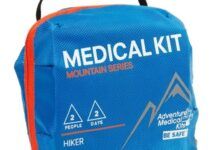Copperpoxy Saga In light of your recent letters on copper/epoxy antifouling bottom coatings, Id like to share my experience. Near the end of my Searunner trimaran boatbuilding project, I decided to apply a product known at the time as Copperpoxy. I applied the coating to all three hulls to about 20 mils thick, and then sanded this “orange peel” surface down to about 10 mils. I finished up with 220-grit sandpaper. In the end, it was beautiful. It was just like a perfectly smooth, new copper penny, and just a bit thicker than recommended. Photo courtesy of Mark Johnson 288 We started our cruising adventure in the foul waters of Beaufort, S.C. Very soon, I was doing a huge scrape job every week. The bottom was covered with grape-size barnacles. I noticed that the aft half of the main hull, the part with underwater metals, was fouling the worst. (I was changing zincs every week.) Two years later, in Pensacola, Fla., we decided to give up on this product and paint over it with Pettit Trinidad SR bottom paint. When doing the weeks-long prep for this painting, we could see that the skin of our epoxy/ply boat was electrically conductive and corroding all the way through in the entire area of the bonded shaft, strut, prop, gudgeons, and copper mast ground. We put on three coats of Trinidad, waited a few days, and splashed the boat. Within two weeks, the new paint had peeled off in the electrically active area. We re-hauled, stripped the paint in this area, and coated the problem Copperpoxy area with three coats of epoxy. After sanding and repainting, we set off for the Western Caribbean. Over the following six months, we noticed that even the epoxy would not stick to the Copperpoxy. Back in the states, I realized that I had to remove the 10 mils of dead Copperpoxy in this large area. I had to do this with 36-grit sandpaper, without ruining the thin glass/epoxy protecting the hull, then re-epoxy, sand, and repaint with Trinidad. This time, it worked! Over the years, I have finally gotten off enough Copperpoxy to keep my bottom paint from failing. In my 36 years of building and sailing my own creations, this stands alone for sucking up about a year of my life and probably over $10,000. Use these and other “new” products with this in mind. Bond failures with any paint or epoxy are harder to fix than one can imagine. Mark Johnson Stray current, along with galvanic corrosion, can also lead to the symptoms you describe. Ultrasonic Antifouling? I recently saw an article on the application of ultrasonic technology to the problem of antifouling. Ive searched the web for independent confirmation that this works, but found nothing. This would be a great test for Practical Sailor, because if this is a viable product, it could significantly reduce the need for toxic bottom paints. Larry Brooks Weve contacted the maker of an ultrasonic antifouling device, Ultrasonic Antifouling Ltd., and they have agreed to send us a product for review. The United-Kingdom-based company does not yet have a U.S. distributor, but you can buy online at 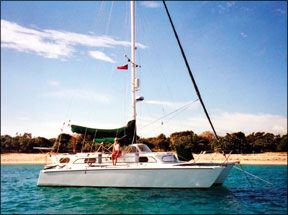
Delphys, Sea Runner 34
Caribbean
Via e-mail
Fogmate
The March 2009 issue (Chandlery) mentioned the Signal Mate product. An alternate, smaller, and less expensive product is the FogMate (www.fogmate.com).
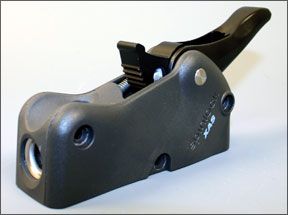
288
It is marketed as an automatic horn device. I installed this a year ago, because using my Icom VHF fog horn option required a hailer horn of 4-ohm rating, which was much larger than just the Ongaro compact horn I chose to mount on the mast. The FogMate unit can be installed remotely, and only a panel-mounted toggle switch is needed to activate it. So far, it has worked well.
Frank Tansley
Grace, Hans Christian 41T
Ventura, Calif.
Lunchbox Solution
Regarding the Fujinon FMTRC-SX binoculars (PS, April 2009), for which no case is provided, I found that an L.L. Bean lunchbox (Item TC27477, $12.50, www.llbean.com) is a perfect fit, and provides an excellent padded case.
Art Herrick
Catalina 27
Long Island Sound, N.Y.
Clutch Durability
I just read your review of rope clutches in the March 2009 issue. I have a 2001 Bavaria 37 sloop with two factory-installed RC750 triple clutches manufactured by Rutgersen. In addition, my dealer added two Spinlock XAS clutches, which were placed next to each of the Rutgersen clutches. In less than five years, the plastic housing of both Spinlock clutches cracked virtually at the same time. I wrote multiple e-mails to Spinlocks customer service, with no replies. I finally gave up and replaced the clutches. I might add that my triple Rutgersen clutches are still going strong after more than seven years!
Steven T. Halperin
Calliope, Bavaria 37
Larchmont, N.Y.
Load cycling, ultraviolet rays, and impact take their toll on plastic hardware. Weve seen failures like yours in older XAS Spinlock clutches. The newer plastic-body clutches seem to better resist wear and tear. Durability is one reason
PS favored the more rugged (and more expensive) aluminum-body Spinlock XCS in our most recent test. Spinlocks XTS, which differs significantly from your XAS, was Recommended for budget-oriented sailors looking for lightweight clutches with a sure grip.Pressure Cookers
I wondered if you were going to be looking at pressure cookers, as a quite a few
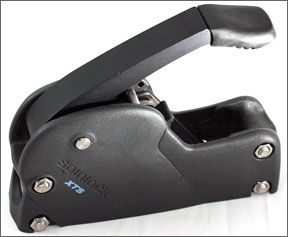
288
long-term cruisers seem to swear by them. We were just at the Chicago Strictly Sail show, and there was a vendor selling both pressure cookers and nesting cookware. Some of the features did seem to make more sense than the competitions, but there is very little about them elsewhere on the Web, and so it would be nice to get an objective comparison of them.
Mark Tilley
Sojourn, Northern 29
Brampton, Ontario
In our last report (May 15, 2000), testers preferred the Kuhn Rikon Risotto (
www.kuhnrikon.com) over the Presto (www.gopresto.com) and Fagor Rapido (www.fagoramerica.com) pressure cookers. We will be updating this test soon.Seasickness Remedy
Regarding your January 2009 report on seasickness meds: I sail a C&C 37 TR in all sorts of heavy weather on Lake Erie. On a sail between Lorain, Ohio, and Leamington, Canada, we had to deal with 25- to 30-knot winds and 7- to 9-foot seas on a reach. One of my crew became very seasick on the outbound passage, so I suggested she drive the boat back. The seas had built to 8 to 10 feet. Once out of the Leamington Marina, the sick crew member drove all the way to Lorain at speeds well over 11 knots without a trace of seasickness. If only one crew becomes seasick, having them drive is a much better remedy than consuming drugs.
Dr. Charles F. Barth
C&C 37
Lorain, Ohio
Prop Protector
Im looking for line cutters for my propeller/shaft, but can’t find any tests in your archives. Can you point me in the right direction?
Alec McCandless
Sisu, Nauticat 36
Guilford, Conn.
We compared the Prop Protector (
www.prop-protector.com) and the Spurs (www.spursmarine.com) in 1996. Testers favored the less expensive and easier to install Prop Protector, but both worked. Contributor Bill Seifert has a low budget solution: a serrated knife lashed to a boathook. Even better, steer clear of those little white balls.Waxing Up
I know you were conducting a wax comparison test this past year, and Im awaiting results from the end of season. I am sort of a fussy restoration kind of guy. I spend
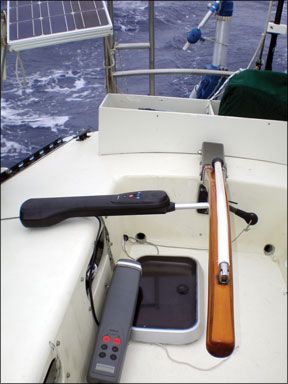
Photo by Skip Allan
288
much time and money on doing things and doing them right. Last season, I buffed my gelcoat four times, six on the boot stripe, and waxed everything with carnuba wax. Was I pleased? Yes. There is no quick and easy wax job. It is a five-part process to get your gelcoat looking good.
Tom Sheaves
Mirage 35
Dartmouth, Nova Scotia
A photo of Tom Sheaves Mirage appeared in last months Mailport section. Unfortunately, we mistakenly identified the boats owner as William Solberg, the author of a similar letter on waxes. Our six-month update on paste waxes is due soon.
FilterBoss
In the April 2007 issue, you did a piece on the FilterBoss fuel system, indicating you were installing it on one of your boats and would report on its performance. I havent seen anything yet. Im having a boat built and would like to add the system. Can you give any preliminary feedback on your experience?
Doug McLean
Madison, Wis.
Via e-mail
The FilterBoss has worked flawlessly on our Union cutter for two years, and we plan to look at fuel polishing systems, as well as do-it-yourself options, again. Many readers have had success building their own system for less, using quality Racor filters and fuel transfer pumps rated for continuous duty. Also, keep an eye out for our upcoming report on diesel fuel additives.
Navico TillerPilot
I have an old Navico tillerpilot. The manufacturer no longer services it. Can you suggest someone who can fix it? It works fine for a few minutes, then wanders.
Eric Camiel
Via e-mail
The old Navico tillerpilots TP10, 20, and 30 were converted to the Simrad TP10, 20, and 30, about 10 years ago. The two larger models were updated to the TP22 and TP32 (adding interface capability).
There are some even older Navico tillerpilots as well, the TP1000 and TP1600, but these look very different from the current models. Production and support for these ended more than 12 years ago.
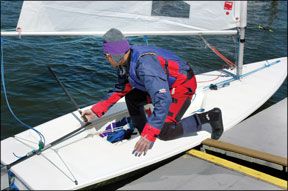
Photo by Ralph Naranjo
288
Obviously, all of the Navico tillerpilots are well out of warranty. However, if it is one of the newer (and we use that term loosely) grey TP models, it can be serviced with Simrad parts by anyone who services Simrad tillerpilots. Look for our Ocean Tested report on entry-level tillerpilots next month.
The Ronny Rollover
I appreciated the article on drysuits in the March 2009 issue, and it brought to mind the Ronny “Rollover” that I bought in the early 1990s. This consisted of a seam-sealed Farmer John with a loose-
fitting dry top. The ingenious feature was a rubber gasket at the waist of the Farmer John, which allowed the creation of a waterproof seal by rolling the tail of the top inside the rubber gasket. It was much easier to put on than a zippered drysuit, and considerably cheaper.
I used it for about 10 years to extend the windsurfing season in Maine, until the rubber gasket finally tore. I was unable to find out what happened to the Ronny company.
Gilliam Johnston
ODay Javelin
Messalonskee Lake, Sidney, Maine
We found some Ronny wetsuits on
www.ebay.com, but not the kind you describe. Perhaps another reader knows their fate?More on Drysuits
The March 2009 article on wet and drysuits was a good start, but I think that could PS could have spent a little more ink on the drysuits and their benefits to not only the hardcore “wet” sailors, but those who often sail in colder water.
Sea kayakers, like myself, typically use dry or semi-dry suits for immersion protection in cool to cold water while paddling. With proper layering underneath, a drysuit can keep you quite warm if you happen to go into 40-degree water. While they may not be a cold-water survival suit, a quality drysuit, with proper layering, is pretty close. I typically wear a drysuit when single-handing when the water is 55 degrees or colder.
The advantage of a drysuit over a wet suit or survival suit is that a drysuit is comfortable to wear and could be worn as primary foul-weather gear while on board.
While Gill may make drysuits, companies like Kokatat, NRS, Stohlquist, and others
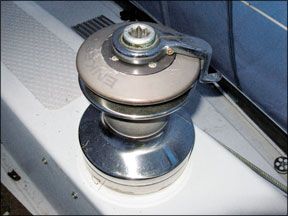
288
make outstanding quality and comfortable drysuits that have a variety of features, including Gore-Tex fabrics, multiple pockets, storm hoods, etc. to fit a variety of budgets.
Bill Hurley
Moondance, 1979 Pearson 10M
Marblehead, Mass.
Enkes Winches
We have a 36-foot pilot-house sailboat, that is not a very well known make. It is a Nautilus 11M, built by Aztec Yachts in Ontario. Only five were built as one of the two partners passed away suddenly in the late 1980s, and the surviving partner chose not to continue the business. The boat sails very well and is well balanced with a comfortable motion.
Now to my question: The genoa winches are made by Enkes. They work well, strip and reassemble easily, etc. However, winch handles have a tendency to work upward in the socket, to the point that one must be careful it doesn’t fall right out. I am looking for information on how to secure this part without reducing the ability to strip the winch for maintenance.
As far as I know, Enkes were made in Holland, but I cannot find any information about them. Do you or your sources have any information about Enkes winches?
Dan Moscovitch
Nautilus 11M
Chester Basin, Nova Scotia, Canada
We put you in touch with Holland Marine (
www.hollandmarine.com), a former distributor of Enkes that still carries some parts for Enkes winches. The technicians suspected your problem could be remedied with a new retaining ring (snap ring) at the bottom of the winch. If the ring is broken or missing, the central stem will ride up. If other readers have other sources for Enkes winch parts, wed be interested in learning of them.


























